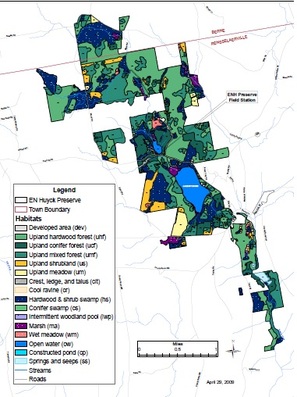Conducting Research
The Huyck Preserve and Biological Research station has a long history of scientific research. In an average year, 15-30 researchers visit Huyck Preserve from around the world to conduct research on a wide range of topics such as forest succession, gap ecology, fern physiology, acoustic communication, disease ecology, and more. Research activities are coordinated by the Director of Conservation and Education (DCE). The DCE invites scientists interested in conducting research at the field station to contact us directly to discuss potential research proposals that will be well-served by the Preserve's resources, facilities, and biology, and that do not interfere with ongoing programs. Short research reports are requested annually for both finishing and continuing projects. Research, teaching, collecting, or activity of any kind requires permission from the DCE. Requests for research support as part of our Huyck Research Grant program are due yearly by the third Friday in February.
Visiting researchers have access to our field station facilities, equipment, and computer network services. Researchers must submit a research proposal for review by our Scientific Advisory Board. All station residents pay lodging and facilities fees. Please note that anyone wishing to stay at the station must contact [email protected] to secure a housing reservation.
Visiting researchers have access to our field station facilities, equipment, and computer network services. Researchers must submit a research proposal for review by our Scientific Advisory Board. All station residents pay lodging and facilities fees. Please note that anyone wishing to stay at the station must contact [email protected] to secure a housing reservation.
The Location
The Preserve is located on the western edge of the Helderberg Plateau (42 10’N, 74 10’W) with elevation ranging from 360 to 650 meters. The Plateau, 117 km square, has a well defined 260 meters escarpment that rises abruptly from the Hudson Valley in the east and the Mohawk Valley to the north. The elevation of the Plateau rises toward the west reaching a maximum of 600 meters on the western most portion of the Preserve. The Catskill Creek to the southwest and Schoharie Creek to the northwest separate the Plateau from the Catskill Mountains.
Climate & Habitat
|
The climate of the Helderberg Plateau is essentially continental although influenced by the Hudson River, Great Lakes, and Atlantic Ocean. Winters (Dec-Feb) are cold (mean = -6.6C) to frigid (min. = -32C) with ample snow (mean = 1.3 m/yr). Summers are warm (mean = 21C) with short periods where 38C may be reached. Rainfall is higher in spring and fall than in summer, with an annual mean total of 900mm. Winds are northerly in winter and northwesterly in summer. Weather data available for the Preserve and for Albany County (back to 1871) were summarized by Thaler (1992, 1994). The Preserve’s research and monitoring record provides valuable baseline data against which change may be evaluated.
Natural habitats on the Preserve include several waterfalls, a 40.5 ha lake, 4 ha pond, beaver ponds, kilometers of perennial and intermittent streams, a bog (total wet areas = 5%), old fields (15%), mature hemlock forests, pine and spruce plantations (3%), and extensive areas of maturing and mature hardwood forests (72%).The remaining 5% are roads, trails, and building sites with our 12-mile trail system traversing the core of the Preserve. |



